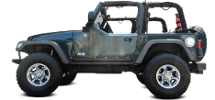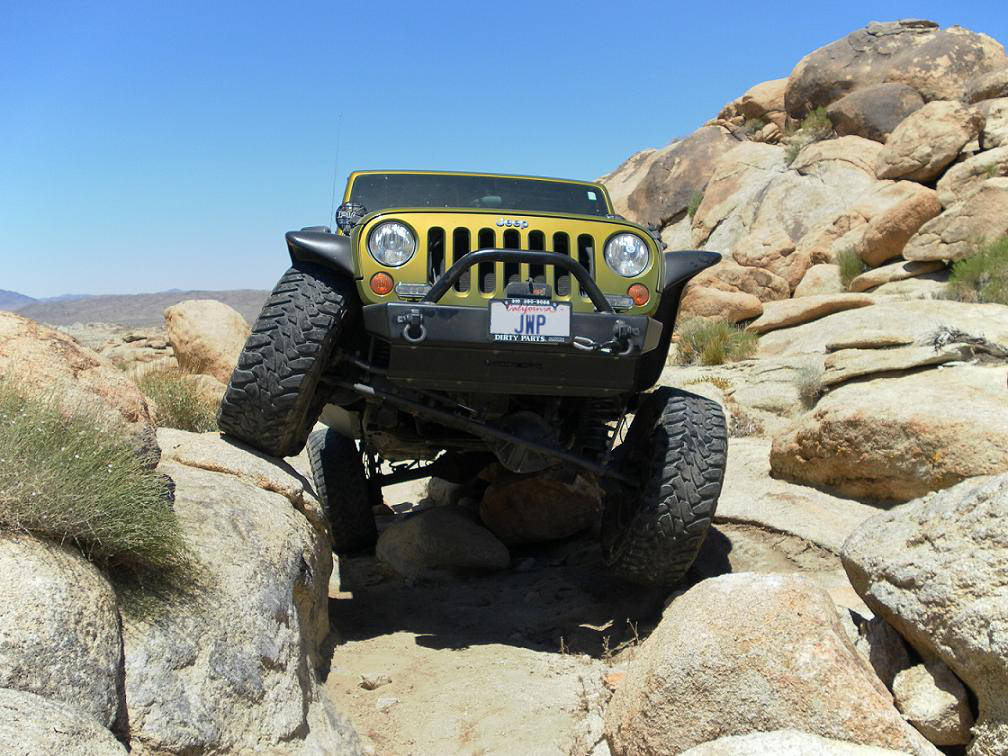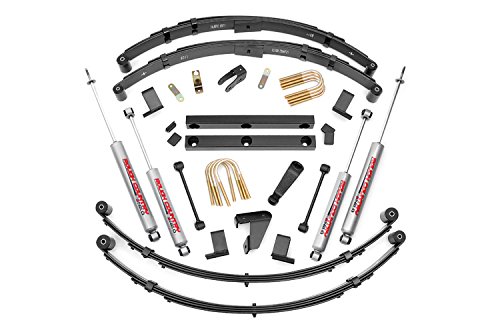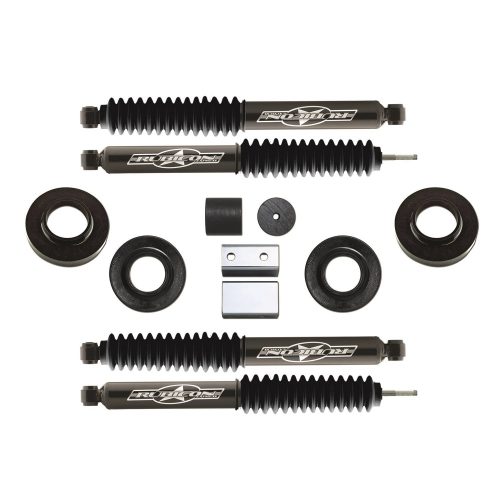A Jeep Wrangler lift kit is one of the first upgrades that many Jeep owners consider. A quality lift kit will allow you to fit bigger tires, and the added clearance will help you get over rocks, and through mud and water. When I first looked into lifting a Jeep Wrangler I had tons of questions – Which Jeep Wrangler lift kit is the best? Do I really need to spend money on control arms? Will this be enough lift for the tires I want to run? In this article, I’ll go over the common type of lift kits, and the various components involved.
Overview:
- What exactly is a Jeep Wrangler lift kit?
- Body Lifts
- Lifting a Jeep Wrangler YJ
- Lifting a Jeep Wrangler TJ or JK
- Summary
What exactly is a Jeep Wrangler lift kit?
Earlier Jeep Wrangler YJs (1987 – 1996) were supported by leaf springs. Lift kits for these earlier Wranglers were essentially just taller springs (springs with more arch in them). All you really had to do to lift your YJ was to replace their leaf springs, and possibly your trackbar, shocks, and pitman arm.
Newer Jeeps (1997+) use coil springs to support the Jeep. To lift one of these Jeeps you just need to make the coils taller – either putting a spacer on top of the coil (commonly called a budget boost), or by replacing the spring entirely. A budget boost is easy, and can commonly be done for $100 – $200, and will net you around 2 inches of lift. If you want to go 4 inches or higher, then you’ll need a more complete kit, with new coil springs, shocks, control arms, track bar (also called a panhard bar), and possibly more.
Body Lifts
A body lift is just what the name implies – you are raising just the body of the Wrangler, and this style of lift applies to any Wrangler (but buy a kit specific to your year). All Wranglers are what we call “body on frame” – this means that there is a frame that the suspension and drivetrain are connected to, and sitting on-top of that frame is the body of the Jeep. A body lift is really nothing more than spacers (they look like hockey pucks) that go between the body and the frame. With a body lift in place, there will be more room in the wheel wells to allow for bigger tires, and when you add bigger tires, you are essentially lifting the Jeep up higher.
Body lifts can normally be purchased in heights ranging from 1-3 inches, however I would not recommend anything higher than 2 inches (I personally run a 1.25″ JKS brand body lift). When you get a very high body lift (as in 3 inches), it starts to look goofy, and could be dangerous (the body mounts will get stressed, and you risk having them sheer off). Body lifts can be one of the most cost effective ways to gain a few inches and run larger tires.
Lifting a Jeep Wrangler YJ
As mentioned earlier, lifting a YJ is fairly straight forward. You’ll be replacing the springs on your Jeep Wrangler, so you just need to select a lift kit that’s the height you want (common heights are 2.5 and 4 inches) – you should read our YJ lift kit reviews before making your decision.
As you can see in this photo, this is a very complete Jeep Wrangler lift kit for a YJ. It offers replacement springs, shocks, pitman arm, swaybar links, as well as hardware to relocate the front and rear trackbars. It even offers a transfer case lowering kit should you need it. This is a great example of a complete YJ lift kit.
Lifting a Jeep Wrangler TJ or JK
There are generally two types of lift kits available for a newer Jeep Wrangler, either what’s called a budget boost (a spacer), or a full lift kit. Lifting a newer Jeep above 3 or 4 inches can be more difficult because when you make the springs taller, that changes the geometry on the control arms. Many times this comes down to installing the lift kit, doing an alignment, and seeing if additional tweaks are necessary. We’ll discuss the smaller budget boost / spacer lifts first.
Jeep TJ & JK Budget Boost lift kits
This is an example of a quality budget boost. It includes spacers that will sit on top of your existing factory coils, as well as new shocks, and new bump stops. This is all you need to add 2 inches to your Jeep TJ or JK, and the install is relatively easy (from 2 to 4 hours). If you want to save even more money, you can skip the shocks, and continue to run your factory shocks – just be aware that if your suspension droops to low (while offroading), it will be easy to destroy that shock. This happens when the tire / axle goes too far down, and the shock is what limits the tire travel. Be sure to read our Jeep TJ lift kit reviews or our Jeep JK lift kit reviews before making your selection.
Jeep TJ & JK suspension lifts
At this point your wallet will likely become the number one priority in the selection process. A full suspension lift can run between $500 and $5000, depending on how complete the kit is, and how high you want to go. If you keep the lift at 3.5 inches or less, then you likely won’t need new control arms, and it’s possible to get away without shocks or a new adjustable track bar. If you go 4 inches or more, then all bets are off. You’ll need something like this:
As you can see from the image, this Jeep Wrangler lift kit includes springs, upper and lower control arms, shocks, a trackbar, extended brake lines, swaybar links and more. Not included in this kit is a new slip yoke eliminator and rear driveshaft – these items are required to fix the drive-line vibrations that are common on highly lifted Jeeps, and will likely add another $500 – $1000 to the total bill.
The overall idea of a full suspension lift like the above is to replace your stock springs with new longer ones, thus making the Wrangler stand alittle taller. When you lengthen the springs, you’ll also need longer control arms, swaybar links and trackbar to keep the geometry correct. Longer shocks and brake lines are needed to prevent these items from getting damaged / ripped in half when your (now longer) wheels flex out.
Summary
As you can see selecting a Jeep Wrangler lift kit isn’t hard, however there are enough options that it can seem more difficult than it is. Start your selection process by deciding on your budget and the amount of lift you’d like. If you’re going to couple your lift with some new tires, make sure the tire size and lift size match up. Once you lift your Jeep you’ll also need a new alignment, so don’t forget to set aside $75 for that as well. The most important part of lifting your Jeep is to try and decide where you want to end up – you don’t want to buy a 2 inch lift now, just to turn around and buy a 4 inch lift in six months.
And remember, have fun out there!







Hi Mason,
Thanks for your excellent posts. In the section above called Body Lifts, there is a note that says “(I personally run a 1.25″ suspension lift).” Did you mean body lift here and not suspension lift? A 1.25″ suspension lift would not be much and a body lift would fit better here in this section.
Thanks
You’re absolutely right. I meant to say body lift. I’ve corrected the article
Can i put a turbo kit on my 2.5. Y2k jeep